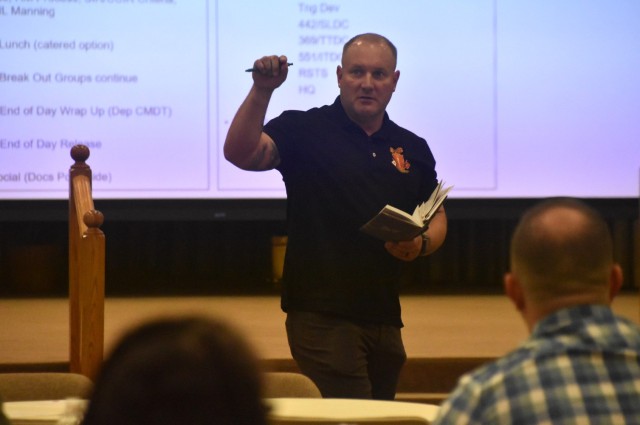AUGUSTA, Ga. – Changes in Army leadership oftentimes bring on changes in units; some being more complex than others. Such was the case for the U.S. Army Signal School and 15th Signal Brigade.
To navigate through those changes, staff from both organizations gathered for a “working offsite” Oct. 29-30. Led by the 43rd Chief of Signal and U.S. Army Signal School Commandant, Col. Julia Donley, and 15th Signal Brigade Commander, Col. William Cherkauskas, the event took place off the installation in an environment where staff could exchange ideas and discuss the way ahead with minimal outside distractions.
“A lot of things have changed in the past year that we need to work through,” explained John Batson, U.S. Army Signal School deputy commandant.
The most significant change has been a reorganization of the Signal School and 15th Signal Brigade into “essentially a single entity with the instructors executing training under the supervision of the battalions and the brigade,” Batson said. “What didn’t come with that reorganization – other than just the structure piece – were the processes that we all need to know, understand, and follow to continue to let things run smoothly.”
The offsite was originally scheduled for a month prior, but Hurricane Helene disrupted those plans. Despite numerous challenges associated with the hurricane’s aftermath, Donley said it led to the two entities joining together in ways that proved successful in the end.
“Instead of doing the offsite, we did the hurricane itself … and considering the disaster we were involved in, the team worked together really, really well, so it’s actually better now that we can take the lessons learned we have from the hurricane and apply them to how our relationships need to work together,” Donley said.
Unlike previous offsites, which primarily centered on informative presentations and guest speakers, this offsite required critical thinking and active participation from all attendants.
Topics covered included: Academics, Civilian Awards, the Operations Process, Budget Operations, Serious Incident Reporting and Commander’s Critical Information Requirements Criteria, and Officer/Enlisted Manning Process.
Personnel were divided into working groups and collaborated to develop possible courses of action for the problem statement assigned to their individual group.
For example, staff assigned to the Operations Process working group received the problem statement: “With the reorganization of the U.S. Army Signal School, how does the organization realign personnel and resources to execute the operations process in the most effective manner?”
On Day 2 of the offsite, each group presented their proposed courses of action to Donley and Cherkauskas so they can make decisions on the processes needed to write that will go into the updated Training and Doctrine Command Regulation 10-5, yielding the best possible outcome for all.
“The whole goal was to have decisions made, change how we’re doing things or codify how we’re doing them today, so that everyone’s roles and responsibilities are clear,” Donley said. “I think we did a lot of that these two days based on your hard work.”
Leadership also took time to recognize several members of the team for their recent efforts in support of the Signal Regiment.
In closing, the 25th Regimental Command Sergeant Major, Command Sgt. Maj. Linwood Barrett, expressed gratitude for everyone’s efforts.
“Thank you for all you do for the Regiment, for the Signal School, and for our team here,” Barrett said. “Keep getting after it, and if you need some assistance, let us know.”














Social Sharing